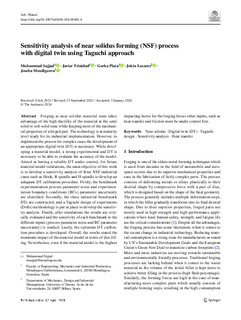| dc.rights.license | Attribution 4.0 International | * |
| dc.contributor.author | Sajjad, Muhammad | |
| dc.contributor.author | Trinidad Naranjo, Javier | |
| dc.contributor.author | Plata, Gorka | |
| dc.contributor.author | Lozares, Jokin | |
| dc.contributor.author | Mendiguren, Joseba | |
| dc.date.accessioned | 2024-04-11T09:07:12Z | |
| dc.date.available | 2024-04-11T09:07:12Z | |
| dc.date.issued | 2025 | |
| dc.identifier.issn | 2195-3597 | en |
| dc.identifier.other | https://katalogoa.mondragon.edu/janium-bin/janium_login_opac.pl?find&ficha_no=174502 | en |
| dc.identifier.uri | https://hdl.handle.net/20.500.11984/6348 | |
| dc.description.abstract | Forging at near solidus material state takes advantage of the high ductility of the material at the semi solid or soft-solid state while keeping most of the mechanical properties of a forged part. The technology is at maturity level ready for its industrial implementation. However, to implement the process for complex cases the development of an appropriate digital twin (DT) is necessary. While developing a material model, a strong experimental and DT is necessary to be able to evaluate the accuracy of the model. Aimed at having a reliable DT under control, for future material model validations, the main objective of this work is to develop a sensitivity analysis of three NSF industrial cases such as Hook, R spindle and H spindle to develop an adequate DT calibration procedure. Firstly, the benchmark experimentation process parameter noise and experimentation boundary conditions (BCs) parameter uncertainty are identified. Secondly, the three industrial benchmark DTs are constructed, and a Taguchi design of experiments (DoEs) methodology is put in place to develop the sensitivity analysis. Finally, after simulations the results are critically evaluated and the sensitivity of each benchmark to the different inputs (process parameter noise and BC parameter uncertainty) is studied. Lastly, the optimum DT calibration procedure is developed. Overall, the results stated the minimum impact of the material model in terms of dies filling. Nevertheless, even if the material model is the highest impacting factor for the forging forces other inputs, such as heat transfer and friction must be under control first. | en |
| dc.language.iso | eng | en |
| dc.publisher | Springer Nature | en |
| dc.rights | © 2024 The Authors | en |
| dc.rights.uri | http://creativecommons.org/licenses/by/4.0/ | * |
| dc.subject | ODS 9 Industria, innovación e infraestructura | es |
| dc.subject | ODS 12 Producción y consumo responsables | es |
| dc.subject | Near solidus | en |
| dc.subject | Digital twin (DT) | en |
| dc.subject | Taguchi design | en |
| dc.subject | Sensitivity analysis | en |
| dc.subject | Heat transfer | en |
| dc.title | Sensitivity Analysis of Near Solidus Forming (NSF) Process with Digital Twin Using Taguchi Approach | en |
| dc.type | http://purl.org/coar/resource_type/c_6501 | |
| dcterms.accessRights | http://purl.org/coar/access_right/c_abf2 | en |
| dcterms.source | Advances in Manufacturing | en |
| local.contributor.group | Procesos avanzados de conformación de materiales | es |
| local.description.peerreviewed | true | en |
| local.identifier.doi | https://doi.org/10.1007/s40436-024-00482-4 | en |
| local.rights.publicationfee | APC | en |
| local.rights.publicationfeeamount | Acuerdo transformativo Springer | en |
| local.contributor.otherinstitution | https://ror.org/00ne6sr39 | en |
| local.source.details | Vol. 13. Pp. 322-336, 2025 | |
| oaire.format.mimetype | application/pdf | en |
| oaire.file | $DSPACE\assetstore | en |
| oaire.resourceType | http://purl.org/coar/resource_type/c_6501 | en |
| oaire.version | http://purl.org/coar/version/c_970fb48d4fbd8a85 | en |
| oaire.funderName | Comisión Europea | en |
| oaire.funderIdentifier | https://ror.org/00k4n6c32 / http://data.crossref.org/fundingdata/funder/10.13039/501100000780 | en |
| oaire.fundingStream | Research Fund for Coal and Steel (RFCS) | en |
| oaire.awardNumber | RFCS-2018-800763 | en |
| oaire.awardTitle | Hybrid Semi-Solid Forming (HSSF) | en |
| oaire.awardURI | Sin información | en |








